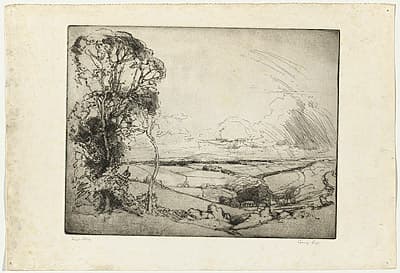
Sydney
LONG
Australia
1871
–
London
1955
England, Europe 1910-21; Australia 1921- 22; England 1922-25; Australia 1925-52; England from 1952
30.0 (h) x 39.0 (w) cm
undesignated impression , 1st state , edition unknown , no manufacturer's mark
Signed lower right below plate-mark in black pencil, 'Sydney Long.' Not dated. Not titled. Inscribed with edition details lower left below plate-mark in black pencil, 'First State'.
Reference: Mendelssohn (1979), 120 National Gallery of Australia, Canberra NGA 1977.9.93 The Stephen Collection, purchased 1976. Reproduced with the kind permission of the Ophthalmic Research Institute of Australia
- J.W.F. Stephen, who formed a definitive collection of the etched work of Sydney Long. J.A.C. Stephen, the artist’s son, by descent. Purchased by the Australian National Gallery, from J.A.C. Stephen, Sydney, 1977.
The rural view of Pastoral landscape is that depicted in the oil painting, Landscape, Richmond NSW (private collection). Opening out to a patterned valley of delineated fields, a small homestead surrounded by trees nestles into the landscape. The scene, finely rendered in line etching and drypoint, is dominated by the vast expanse of sky, and is detailed only by the soft haze of plate tone and hatched-in clouds. Of the oil painting,
the poet W.H. Honey wrote in 1934,
An open space revealed a beauteous place:/ Dim ringed with dark blue hills and pink-tipped clouds,/ And fields of verdure green, and brown leaved trees,/ And quietude serene — most lovely scene.
Long enjoyed the carefree bohemianism
of painting camps near Richmond in the 1890s. Situated north-west of Sydney, the region was popular with artists working in the plein air tradition, such as Arthur Streeton, Charles Conder, A. Henry Fullwood and Julian Ashton, who set out on painting expeditions to capture the picturesque countryside and majesty of the Hawkesbury River.
Another copy, where the print has been cut down to plate size, is held by the National Gallery of Australia.
Emma Kindred
The rural view of Pastoral landscape is that depicted in the oil painting, Landscape, Richmond NSW (private collection). Opening out to a patterned valley of delineated fields, a small homestead surrounded by trees nestles into the landscape. The scene, finely rendered in line etching and drypoint, is dominated by the vast expanse of sky, and is detailed only by the soft haze of plate tone and hatched-in clouds. Of the oil painting,
the poet W.H. Honey wrote in 1934,
An open space revealed a beauteous place:/ Dim ringed with dark blue hills and pink-tipped clouds,/ And fields of verdure green, and brown leaved trees,/ And quietude serene — most lovely scene.
Long enjoyed the carefree bohemianism
of painting camps near Richmond in the 1890s. Situated north-west of Sydney, the region was popular with artists working in the plein air tradition, such as Arthur Streeton, Charles Conder, A. Henry Fullwood and Julian Ashton, who set out on painting expeditions to capture the picturesque countryside and majesty of the Hawkesbury River.
Another copy, where the print has been cut down to plate size, is held by the National Gallery of Australia.
Emma Kindred
The rural view of Pastoral landscape is that depicted in the oil painting, Landscape, Richmond NSW (private collection). Opening out to a patterned valley of delineated fields, a small homestead surrounded by trees nestles into the landscape. The scene, finely rendered in line etching and drypoint, is dominated by the vast expanse of sky, and is detailed only by the soft haze of plate tone and hatched-in clouds. Of the oil painting,
the poet W.H. Honey wrote in 1934,
An open space revealed a beauteous place:/ Dim ringed with dark blue hills and pink-tipped clouds,/ And fields of verdure green, and brown leaved trees,/ And quietude serene — most lovely scene.
Long enjoyed the carefree bohemianism
of painting camps near Richmond in the 1890s. Situated north-west of Sydney, the region was popular with artists working in the plein air tradition, such as Arthur Streeton, Charles Conder, A. Henry Fullwood and Julian Ashton, who set out on painting expeditions to capture the picturesque countryside and majesty of the Hawkesbury River.
Another copy, where the print has been cut down to plate size, is held by the National Gallery of Australia.
Emma Kindred
